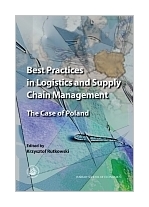|
||
podział tematyczny • wydawnictwa anglojęzyczne podział tematyczny Newsletter: • Zamów informacje o nowościach z wybranego tematu Informacje: • sposoby płatności i dostawy • kontakt • Cookies na stronie • Regulamin zakupów Szukasz książki? Pomożemy Ci! Zadzwoń 512 994 090 Napisz poczta@ksiazki24h.pl |
BEST PRACTICES IN LOGISTICS AND SUPPLY CHAIN MANAGEMENT THE CASE OFRUTKOWSKI K. EDITOR / POLAND /wydawnictwo: SGH , rok wydania 2009, wydanie Icena netto: Table of Contents
About Department of Logistics at WSE About the Authors Preface Krzysztof Rutkowski Acknowledgments Krzysztof Rutkowski
CHAPTER 1 The best practices in business – between the hammer of
economic demands and the anvil of corporate social responsibility Krzysztof Rutkowski 1. The essence of the phenomenon of best practices in business 2. Stakeholders and their infl uence on the perception of the best practices 3. The social responsibility of business and the best practices 4. The best practices in light of the theory of sustainable development and the Triple Bottom Line concept 5. The best practices in logistics and supply chain management in light of selected research of an international scale 5.1. Prologis 5.2 MIT Supply Chain 2020 5.3. AMR 5.4. BestLog Project 6. The best practices – The Holy Grail of contemporary business?
CHAPTER 2 Transferring Best Practices – one solution fi ts all? Richard Cuthbertson, Wojciech Piotrowicz 1. Introduction 2. Methodology 2.1. Transferability limitations (STEEP) 2.1.1. Social 2.1.2. Technological 2.1.3. Economic 2.1.4. Environmental 2.1.5. Political 2.2. Process and product diff erences 3. Summary
CHAPTER 3 Reconfi guration of supply chain structure to increase the role of railway transport. Best Practice Case of IKEA and
COM.40/Correct Barbara Ocicka 1. General description of company and sector 1.1. History 1.2. IKEA on the global arena 1.3. Th e Polish furniture sector 1.4. IKEA in Poland 1.5. Products 1.6. Porter’s 5 forces analysis 1.7. Business strategy of IKEA 1.8. SWOT analysis 2. Supply chain management 2.1. Supply chain structure 2.2. Transport 2.3. Sourcing 2.4. Distribution 2.5. Logistics customer service 2.6. Need forecasting 2.7. Outsourcing and evaluation of logistics processes 3. Reconfi guration of the supply chain structure – Best Practice presentation 3.1. Challenge to IKEA – supply chain restructuring 3.2. Project implementation 3.3. COM.40 and Correct – leaders of the Best Practice project 3.4. Choice of project partners 3.5. Best Practice nature 3.6. Procedure of a new supplier inclusion 3.7. Role of the Best Practice for realisation of the IKEA business strategy 3.8. Best Practice eff ects 3.8.1. Economic benefi ts 3.8.2. Environmental and social benefi ts 3.9. Best Practice transferability 4. Summary
CHAPTER 4 The influence of product development on warehousing and transport efficiency. Best Practice Case of BSH Sprzęt Gospodarstwa Domowego Sp. z o.o. Barbara Ocicka 1. General information about the company and its sector 1.1. Bosch und Siemens Hausgeräte GmbH on the global market 1.2. Business strategy of BSH 1.3. Strategic analysis of the company’s business sector 1.4. Household appliances in Poland – industry profi le 1.5. BSH activities in Poland 2. Global supply chain management 2.1. BSH supply chain concept 2.2. Purchasing 2.3. Warehousing and transport 2.4. Production and assembly 2.5. Distribution 3. Best Practice presentation 3.1. General information about the clothes dryers’ factory in Lodz 3.1.1. Purchasing 3.1.2. Production and assembly 3.1.3. Warehousing and internal transport 3.1.4. Distribution 3.2. Th e infl uence of product development on warehousing and transport effi ciency 3.2.1. Warehousing effi ciency 3.2.2. Transport effi ciency 3.2.3. Eff ects of the Best Practice implementation 3.2.4. Best Practice transferability 4. Summary CHAPTER 5 Pooling impact on effi ciency of logistics processes. Best
business practice of FM Logistic Katarzyna Gapska 1. Company profi le 1.1. FM at a glance 1.2. Services off ered 2. Th e company’s potential 2.1. Quality and company values 2.2. Customer satisfaction 3. Best Practice presentation 3.1. Scope and signifi cance of Best Practice 3.2. Best Practice implementation 4. Th e Best Practice evaluation according to adopted criteria 4.1. Business criteria: eff ectiveness and process development 4.2. Non-business criteria: ecology and social responsibility 5. Best Practice transferability assessment 6. Possibilities of continuous improvement of Best Practice 7. Summary
CHAPTER 6 Multidemensional Benefi ts of a Logistics Network
Transformation. Case Study of DB Schenker in Poland Rafał Tarasewicz 1. Profile of the company 1.1. DB Schenker at a glance 1.2. Competitive position in Poland 1.3. Services offered 1.4. Values and relationships 2. Company’s potential 2.1. Quality and long-term development 2.2. Customer satisfaction 2.3. Employee care 3. Presentation of the Best Practice 3.1. The Best Practice characteristics 3.2. Implementation of the Best Practice 4. The Best Practice evaluation according to adopted criteria 4.1. Business criteria: eff ectiveness and process development 4.2. Non-business
criteria: ecology and social responsibility 4.2.1. Environmental criteria 4.2.2. Social responsibility 5. Transferability of the implemented solution 6. Possibility to continuously improve the Best Practice 7. Summary
APPENDIX A Investment attractiveness – why Poland? Krzysztof Rutkowski 1. Investment attractiveness of Poland 2. Main factors infl uencing investment attractiveness of Poland 2.1. Territory, location, and population 2.2. Strong economy 2.3. Large domestic market 2.4. EU membership 2.5. Foreign trade 2.6. Labour skills and costs 3. CEE and Poland as low-cost sourcing and manufacturing countries
APPENDIX B Developments in logistics, transportation and warehouse markets in CEE countries. The anatomy of Poland Krzysztof Rutkowski 1. Where do CEE countries come from? Where are they going? 1.1. Th e old system. Where do we come from? 2. Th e new system. Where are we going? 3. Transport system in Poland 3.1. General remarks 3.2. Road transport 3.3. Poland’s rail network 3.4. River and sea transport 3.5. Air transport 4. Warehouse market
References 232 pages
Po otrzymaniu zamówienia poinformujemy, |


